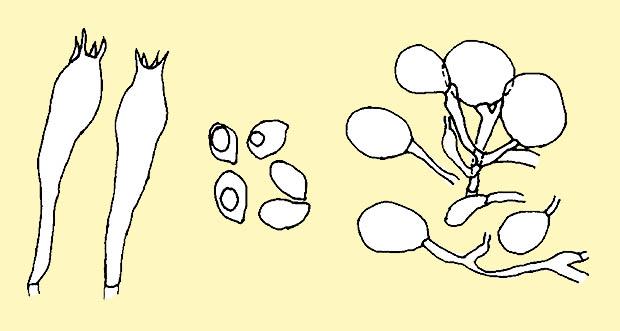
Text © Loredana Battisti

English translation by Mario Beltramini
Sturdy, and grey-brown cap; margin not striated, with pale powdery warts © Giuseppe Mazza
Family: Amanitaceae Roze.
Genus: Amanita Persoon.
Subgenus: Lepidella (Gilbert) Vesely.
Section: Validae (Fr.) Quélet.
Amanita excelsa var. spissa (Fries) Neville & Poumarat 2004.
The name comes from the Latin “spissum” = thick, stout, due to the robust, solid appearance of the mushroom.
The Section Validae is characterized by basidiomata with a hyphal structure mostly sphaerocystic, crumbly, so that the general or universal veil protecting them during the first stage of growth (primary), when breaking, remains completely on the surface of the cap, in the form of small, powdery patches, which can easily disappear. The volva, almost absent, shows some small beads, adherent to the bulb (napiform-rooting volva). Non-striated cap margin. In this Section are found Amanitas with persistently white flesh and others with more or less reddening flesh, most of them are edible, after cooking, as they contain thermolabile toxic substances, between which the hemolysins, which are eliminated with the temperatures of 70-80 °C.
Cap: 8-16 cm, robust, fleshy, from globose to hemispheric to flat-convex, with non-striated margin, colouring from brown to grey-brown, slate-grey, scattered by small white, greyish white powdery warts, more or less adherent.
Hymenophore: lamellae thick, free to stipe, with truncated white lamellulae, fully sharp, concolorous. Spore print white.
Stipe: 1-3 x 6-13 cm, generally robust, slender, cylindrical, fleshy, attenuated at the apex and enlarged at the base in a bulb from sub spherical-ovoidal to napiform, with concolorous pruine and white over the ring. Ring ample and membranous, persistent, white, slightly striated. Crumbly volva, dissociated in small floccose scales, white.

Amanita excelsa var. spissa: basidia, spores, general veil elements on the cap © Pierluigi Angeli
Flesh: thick, compact, persistently white. Smell and taste a little earthy.
Chemical reactions: amyloid spores in contact with Melzer’s reagent.
Habitat: Grows by the end of summer-autumn, both in latifolious woods (oaks and chestnut trees), and in conifer ones (spruces, pines).
Edibility: poor, after cooking.
Notes: this species is easily recognizable due to its appearance rather robust, stumpy, the cap of prevailing greyish colour, with white or greyish warts and non-striated margin, by a base with napiform volva, persistently white flesh, ample ring, membranous, white.
Varieties of the species:
Amanita spissa for. alba (Gilbert) Gilbert, identical to the type, but completely white.
Amanita spissa var. valida (Fries) Dörfelt & Roth = Amanita valida (Fr.) Quélet, which has a more brown-grey universal veil and browning flesh.
Amanita spissa var. excelsa (Fries:Fries) Dörfelt & Roth (= Amanita ampla Persoon), more slender than the type, with more rooting base and almost absent warts.
Amanita spissa var. cariosa (Fries) Gilbert = Amanita cariosa (Fr.) Quélet, similar to the previous, with almost hollow stipe, more rare species.
Remarks : by some authors, it is morphologically considered as a collective species together with the var. excelsa, cariosa, valida, forms mostly due to different ambient conditions, grouped in a unique species: Amanita ampla of Persoon.
It might be mistaken, mainly, with Amanita pantherina, toxic, which distinguishes for the following characters: grey colour of the cap and not brown, non-striated margin, napiform rooting volva, different from the circumcised circinate volva of Amanita pantherina.
→ For general notions about Fungi please click here.
→ To appreciate the biodiversity of MUSHROOMS please click here.
